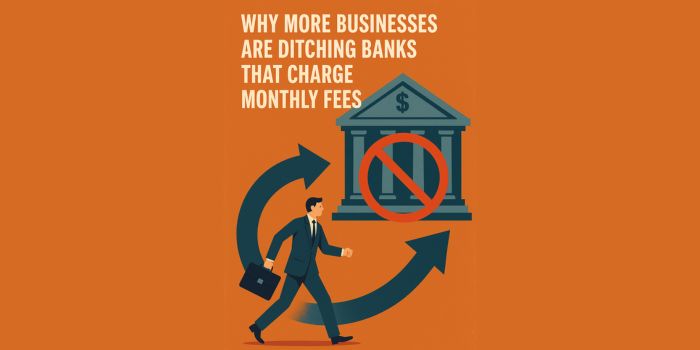There’s been a change in the business mindset toward banking. What seemed like a normal cost of doing business – maintenance fees, transaction charges, minimum balance requirements – started to decline in how many businesses were willing to accept it. The world of banking has changed enough that businesses no longer have to tolerate it, and savvy owners are starting to notice.
In how many ways? A typical business checking account at a bank charges $10 to $30 per month for maintenance fees. That’s $120-$360 per year before they even step foot in the bank or make a single transaction. For a small business, that’s a lot of money that could go toward payroll, inventory or marketing.
Over time, maintenance fees add up quickly in addition to other charges. What most business owners don’t realize is how exponentially smaller charges add up until they do the math and see how much they’re truly paying. Transaction charges, wire transfers, cash deposit fees – and fees associated with surpassing a certain amount of free transfers and deposits – add up over time.
This is where it gets tricky. Banks announce ‘low fees’ but what they fail to mention until you’re locked in is how much everything else will cost. For example, a business may be locked into $15 per month for the actual account but get charged $0.50 per transaction after the initial one hundred. If it’s a retail business, that could be hundreds of dollars over the course of a month – and that’s in addition to the monthly fee that was supposed to cover expenditures. The same is true for service businesses that receive payments frequently or have recurring billing.
Businesses that deal with cash have even worse expenses. Restaurants, retail spots, and service companies that deal with brick-and-mortar currency eventually learn that their banks charge fees just to deposit their money for them. Some banks offer monthly cash deposit amounts at no cost ($5,000-$10,000), but after that, any percentage above costs money. A busy restaurant may deposit $30,000 in cash each month. That could be thousands of dollars per year, just in deposited cash.
What’s Driving the Change Away From Banks That Make You Pay
Why are businesses leaving banks that charge so much per month? Because there are better options. Since fintechs and online banks have developed systems that make it possible to avoid charging monthly fees and still provide relevant services and products without sacrificing standards, it’s changed how businesses seek bank relationships.
Fintechs operate through online banking without a brick-and-mortar space – the overhead is far lower than conventional banks. This is not to say that businesses will receive subpar service; they’re finding the opposite to be true.
For example, if a business has a no fee business bank accountand compares what it’s been paying, savings are astronomical. For a company paying $25 per month plus small transaction fees on top of monthly maintenance (maybe anywhere from $500-$800 annually), these costs, once eliminated means more working capital.
In addition, companies report better technology – easy mobile access and quicker support service. They feel that traditional banks are antiquated and require personal visits for simple transactions or an antiquated online experience through which they need to do everything themselves. Newer companies construct their services digital-first, which is how most companies conduct business on a daily basis.
When Paying Monthly Makes Sense (It Rarely Does)
There are certain situations where it makes sense to pay for your business bank account instead of seeking no-cost options. Banks (even traditional ones) have features that fee-free bank accounts do not – for complicated businesses that need certain resources.
Businesses that need to wire transfer frequently internationally and those that need integrated merchant service capabilities or dedicated treasury management departments may find it worthwhile to pay for their business banking needs.
Also, if businesses have significant funds in checking accounts (i.e., $25,000-$50,000), traditional banks charge little to no maintenance fees but only if certain minimums are maintained. The downfall is that money just sitting there but not growing interest elsewhere or as funds for investment for something else doesn’t make much sense when saving $20 in a month means nothing compared to opportunity costs.
Finally, some people like personal relationships with their banking. Owners might feel happier having a local branch down the street or access to someone who knows their company by name – this helps when loans are involved or complicated situations arise. Yet even this trend is not always persuasive as digital companies increase their customer service and lending access as well.
What You Need To Know About Switching Your Business Banking
Ultimately switching business banking is not as complicated as it used to be. The main headache comes from redirecting all automatic payments and payroll deposits from one account to another – and the need to keep both accounts open until all information sorts itself out.
It’s easier for most new businesses to open a no-fee business account, then over the course of a month or two switch all services, and keep the previous account open until its unused balance has reset. Once everything is confirmed as functional in the new account, closing the old one is seamless.
The documentation required has not changed too much – an EIN verification, articles of incorporation (or however the business was founded) and ID for those who will have access need to be included. Some online options make this part of the process digital-friendly, while other options may require mailing in notarized paperwork.
The biggest benefit is assessment; businesses should assess whether the new bank offers the specific features they plan on using – for most companies, a checking account is fine – but others may rely on savings accounts or multiple access for accounting software benefits. Getting no surprises down the line is most advantageous.
The Big Picture About Business Banking Fees
The reason this latest fee-for-banking trend matters even more is that when operating costs are assessed when running a business now like never before, every monthly payment comes under increasing scrutiny, with recurring charges failing to justify what they are really going for more often than not.
Fees fall into that category when it comes to banking; banks that no longer require repayment for any banking quarterly have no expense, but better options exist where there’s zero cost all around.
It’s only putting pressure on even traditional banks, which are getting loosey-goosey with their fee offerings, as some traditional banks have found little-to-no fee business checking options or reduced avenues requiring qualification. This is good for businesses regardless of where they bank because it gives more options and better terms across the board.
For entrepreneurs starting out as well, if they can start out without paying any fees, even better; it’s easier from the onset – the less working capital they lose monthly (when free options exist) makes sense until their needs grow more complicated and they can justify/reassess switching down the line.
Since it’s impossible to know what one’s working capital will be week-over-week during its first year or two anyway, no one wants extra expenses at an unknown cost – this trend away from charging monthly fees from banks, which feels like a trend, is quickly becoming reality as fewer businesses accept this as an expense of banking unless they have no other option.




